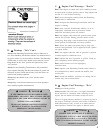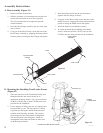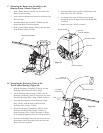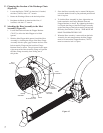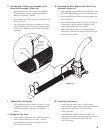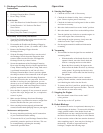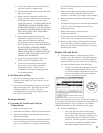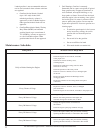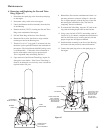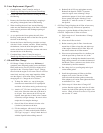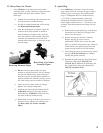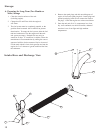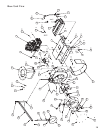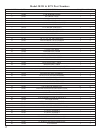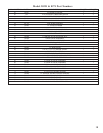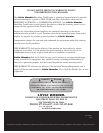
13
B. Liner Replacement (Figure #7)
1. Complete Steps 1 thru 7 found in section A
(Removing and Replacing the Fan and Talon Ring).
2. Unbolt and remove the hardware securing the Liner to
the Housing.
3. Remove the Liner from the housing by wrapping it
and pulling it through the front of the housing.
4. When installing the new Liner into the Housing,
make sure the chamfered edge of the liner is installed
in the vertical position at the discharge opening of
the housing.
5. As you position the Liner against the wall of the
Housing, make sure the holes of the liner line up with
the slots in the Housing.
6. Secure the Liner to the Housing (one hole at a time)
with the 10 bolts, washers, and nuts. When installing
the hardware, insert the bolts through the inside
surface of the liner and install the washers and nuts to
the outside face of the Housing.
7. Complete Steps 8 thru 13 found in section A
(Remo
ving and Replacing the F
an and Talon Ring).
C. Oil and Filter Change
1. Oil Change: Change oil after every 100 hours of
operation (more frequently under severe conditions).
Refill with service class SG, SH, SJ or higher oil as
specified in the “Viscosity Grades” above. Change
the oil while the engine is still warm. The oil will flow
more freely and carry away more impurities. Make
sure the engine is level when filling, checking, and
changing the oil. Change the oil as follows:
a) To keep dirt, debris, etc., out of the engine,
clean the area around the oil fill cap/dipstick
and drain valve before moving to the next step.
b) Attach a 1/2” I.D. hose to the fitting on the oil
drain valve. Place the other end of the hose in
an oil pan. Next, remove the oil fill cap and
dipstick, then open the oil drain valve (counter-
clockwise) to begin drainage. Be sure to allow
ample time for complete drainage.
c) Once all the oil has drained, close the valve
(clockwise) and remove the hose.
d) Fill the crankcase, with new oil of the proper
type, to the “F” mark on the dipstick. Refer to
“Oil Type” on page 11. Always check the level
with the dipstick before adding more oil.
e) Reinstall the oil fill cap and tighten securely.
Reinstall the dipstick. NOTE: To prevent
extensive engine wear or damage, always
maintain the proper oil level in the crankcase.
Never operate the engine with the oil level
below the “L” mark or over the “F” mark on
the dipstick.
2. Oil Filter Change: Replace the oil filter at least every
other oil change (every 200 hours of operation).
Always use a genuine Kohler oil filter, Part No. 12
050 OI-S. Replace the oil filter as follows:
a) Follow steps A to C from the above “Change
Oil” section.
b) Allow the oil filter to drain.
c) Before removing the oil filter, clean the area
around the oil filter to keep dirt and debris out
of the engine. Remove the old filter. Wipe off
the surface where the oil filter mounts.
d) Place a new replacement filter in a shallow pan
with the open end up. Pour new oil, of the
proper type, in through the threaded center hole.
Stop pouring when the oil reaches the bottom of
the threads. Allow a minute or two for the oil to
be absorbed by the filter material.
e) Put a drop of oil on your fingertip and wipe it
on the rubber gasket.
f) Install the replacement oil filter to the filter
adapter or oil cooler. Turn the oil filter
clockwise until the rubber gasket contacts the
filter adapter or oil cooler, then tighten the filter
an additional 2/3 to 1 turn.
g) Follow steps 4-5 from above “Change Oil”
section. Start the engine and check for oil leaks.
Correct any leaks before placing the engine into
service. Check oil level to be sure it is up to but
not over the “F” mark.



